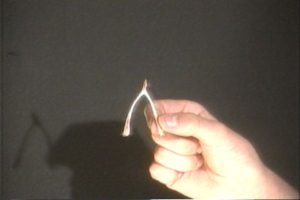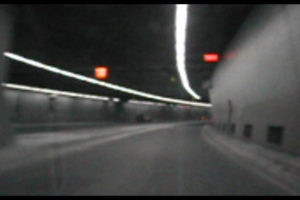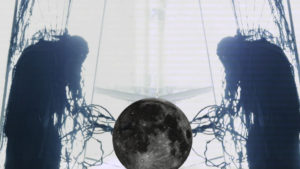Signals + Channels
Curated by Madeline Bogoch
The following videos are available for screening online, from August 23, 2019 at 5pm CT to August 25 at 5pm CT. Enjoy!

Remote Sensing by Jennifer Stillwell
1996 | 5:20
Remote Sensing was originally produced in the mid-1990s for playback on public access TV. In that way, the video self-references systematic time, the electronic form and changing channels through its poetic imagery, sound, and structure, while it also overlaps as an extended metaphor for physical time and its limitations.
If you missed the online screening you can watch Remote Sensing on VUCAVU now!

tunnel by Steve Bates
2004 | 2:49
tunnel is the first in a series of works using consumer-grade and customized audiovisual equipment to investigate the technical and emotional resonance between sound and visual information.
tunnel derives its soundtrack from a music box version of The Carpenter’s “We’ve Only Just Begun”. The familiar is made unrecognizable here as both the melody and the image are altered temporally into an ever-present experience.

Even Lower Astral Entity by Gwen Trutnau
2013 | 7:05
Even lower astral entity is journey into space and violence , using found footage super 8 and digital imagery.
If you missed the online screening you can watch Even Lower Astral Entity on VUCAVU now!
Signals + Channels
by Madeline Bogoch
I spent the summer here at Video Pool caring for the sizeable collection of tapes in the vault. My interactions with the collection were focused on the body of the cassette, the physical asset which is becoming increasingly scarce in film practices. In media conservation there is an ontological paradox of sorts regarding the location of the work itself. Is the piece tethered to its object-ness, and where is the threshold between the material and immaterial value? To counter, or maybe compliment my recent preoccupation and practice of considering video art from a material perspective, I sought out pieces from the collection which touch on the furtive channels of transmission that act as vehicles of content and aura. These three films from the collection traverse the theme of channels from distinct perspectives. Amongst this ambiguity there is a common suggestion of the extent to which our lives are mediated through these unseen transmissions.
By a healthy margin, Jennifer Stillwell’s Remote Sensing (1996) is the oldest of the three films. Originally produced for public access television, the film uses vivid imagery to represent how we absorb electronic information. Each shot contributes to an overall rich sensory environment. Images of a key sliding along a wire, water rippling as it drips, and animated frequencies radiating from objects simulate the friction and flow of electronic signals. The textural acoustic backdrop collaborates with the shrewdly evocative shots to gauge our capacity to digest the chaotic nature of broadcast culture.
I am inexhaustibly drawn to the pun for both its clever levity and economical function. Keeping the theme of “channels” fairly loose allowed me to exercise the term’s polyvalence. and consider the cascade of definitions attached to “channels,” in the case of Steve Bates’ tunnel (2004), as the passage between two points. Throughout the film, the titular tunnel infinitely unwinds on the screen, paired against a melancholic soundtrack taken from a music box version of The Carpenters song We’ve Only Just Begun. Both sound and image are disrupted, producing an asymmetrical spatial and temporal ambience. As the disruptions indefinitely delay the culmination of the journey, the viewer is left to linger in a space of dreamy liminal suspension.
The surreptitious channels by which we travel and communicate (both spectral and electronic) are further explored in Gwen Trutnau’s film, Even Lower Astral Entity (2013). The film was originally produced as an installation and included in an exhibition about electronic voice phenomena (EVP). Trutnau foregrounds this, and other paranormal phenomena, using found footage and recordings to fully capture the eerie residue of these cosmic mysteries. Complimenting the use of found footage is an acute attention to detail and craft which further furnishes the film with its paranormal quality. Such details include the narrator: a snake-like critter whose lives in the moon, and the soundscape which supplies a layered and foreboding atmosphere. Both the soundtrack and the prop were made by Trutnau who excels at world-making through rigorous devotion to aesthetic and acoustic cohesion.
Our capacity to perceive the spectral and terrestrial modes of transmission which covertly saturate our senses is well trodden territory in media studies. What these three titles each contribute to the discourse is a visual and acoustic articulation of these interactions. Using their idiosyncratic aesthetic metrics, each of these artists capture and project the nature of these channels, and their role as mediators of culture and content.
About Madeline
Madeline is a graduate student, in the art history department at Concordia University. Prior to this, she completed her BA between The University of Winnipeg and Concordia. In her academic career her research has been focused primarily in new media practices, specifically: materiality in postinternet art, circulation and dispersion, issues surrounding the preservation of born-digital artworks, aesthetics of obsolescence, and the fusion of high and low culture. Madeline is drawn to work that engages these themes at a critical and material level. In addition to her academic work she is a member of the programming committee for the Winnipeg Underground Film Festival (WUFF).
Through out the summer of 2019 Madeline worked at Video Pool Media Arts Centre as the Archive Intern. The position was generously funded by the Government of Canada through the Young Canada Work program.
